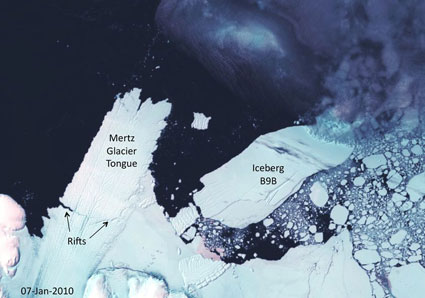“Luxembourg-Sized” Glacier Breaks Off Antarctica; Future Chills for East Coast, Europe?
A roughly 985 square-mile iceberg — every news outlet seems to have settled on “Luxembourg-sized” to describe it, for some reason — has broken off of Antarctica. Scientists fear that the break could change global ocean currents, threaten Antarctic biodiversity, and perhaps lead to permanent cold weather on the East Coast and in Europe decades down the road, Times Online reports.
From their report:
The 985 square-mile (2,550 square-kilometre) block of ice was knocked off the Mertz Glacier Tongue, a spit of floating ice protruding from East Antarctica on February 12 or 13. It was dislodged by an older iceberg, known as B9B, which broke off in 1987.
Although the impact will not be felt for decades, the iceberg could block the production of cold, salty water, known as ‘bottom water’, which could eventually lead to less temperate winters in the North Atlantic.
Topicality: while the primarily British outlets reporting on the split are translating “North Atlantic” to equal “Europe,” the American East Coast is very much in the North Atlantic. (See: the North Atlantic Treaty Organization, i.e. NATO.)
If modern climate science has taught us anything, it’s that long-range predictions based on current trends tend to be controversial things; still, colder North Atlantic winters are not exactly what most East Coasters want to be hearing about right now.
(image via 80 Beats)
Have a tip we should know? tips@themarysue.com
